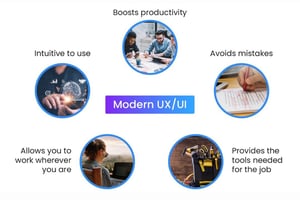
11 Ways for Investment Managers to Increase Operational Efficiency
Cost pressures and a heightened regulatory agenda have forced investment managers to rethink their operating models to drive more efficiency. Many firms are modernising their tech stacks and consolidating systems. We explore the main challenges and how to leverage modern investment management tools to increase operational efficiency.
Key efficiency challenges and frustrations facing investment managers
As a reflection of the wider industry, the volume and complexity of data requirements are growing exponentially. Rapid change alongside increased price volatility has heightened the challenges facing the investment management industry, contributing to additional regulatory pressure, margin compression, fee pressures and changing customer expectations.
Amidst these challenges, it’s becoming increasingly clear that existing systems and infrastructures are struggling to keep pace with the rapidly changing industry landscape, and hindering, rather than helping, investment managers’ operational objectives.
According to PWC intelligence, to remain competitive, firms must look to reduce costs, improve efficiency and increase operating margins across the value chain. This is only achievable with efficient investment management tools that facilitate business needs, increase operational efficiencies, and empower investment managers to focus on their key priority – generating value for clients.
Why businesses are turning to modern investment management software
Whilst customer demands increase, willingness to pay is decreasing, and legacy systems are continuing to hinder operational efficiency, putting investment managers between a rock and a hard place. However, with modern solutions, businesses can access and start leveraging accurate and timely data to facilitate effective decision-making and increased performance, ultimately providing better returns for investors.
Modern investment management software empowers firms through one seamless solution, which enables effective portfolio management, compliance, order management and real-time risk, contributing to overall operational efficiency.
The key reasons businesses are turning to modern investment management tools include:
- Flexibility – Flexible tools give investment managers the ability to incorporate the benefits of their different systems into one platform, configure it to meet their needs and create the data/reporting views requirement for effective analysis and investment decision-making.
- Cloud-native (scalable) – As the volume of asset data that is managed by a firm increases, the cost of traditional IT operations may increase substantially to handle the greater amounts of data. By using a cloud-native investment management solution, firms can scale in line with how much asset data is being generated and managed at any given time.
- Automation – Automating processes offers a host of benefits for firms through pre-determined logic. It not only removes the risk of human error, helping organisations to avoid losses but also streamlines validation processes, guaranteeing consistent decision-making, which promotes organisational efficiency.
- Data consolidation –The ability to consolidate complex information into a single access location drives efficiency within businesses and is critical to success. Data consolidation makes all data management information available quickly and easily, and having all data in one place saves operations teams valuable time and effort.
- Tailored services – Different business motivations, such as complex regulatory requirements, investing according to ESG criteria or the need to adapt to existing (and evolving) investment exposures and liabilities, highlight the importance of utilising investment management software that’s tailored to your business needs. By investing in software that can be configured to your specific business requirements, you can ultimately be sure of client satisfaction and profit maximisation.
- Integrations – As opposed to a traditional, segregated approach to tools, viewing all assets as a coordinated whole lets investment managers utilize each component for its highest and best use, ensuring efficiency throughout the whole management process.
- Modern user interface/usability – Easy-to-use interfaces are a given with most modern-day tools. Investing in cutting-edge investment tools will empower a seamless and user-friendly experience, as data will be much clearer and more engaging to draw insights from for both investment managers and clients.
- Easier maintenance and more support – As a centralised system that allows your organisation to track important details in real-time, investment management tools enable teams to closely monitor their processes and systems for when they need maintenance, upgrades, or replacement. In addition, cloud solutions mean less strain on your in-house IT teams, as maintenance and support are often managed by your solution provider.

Ways to use integrated investment management tools to increase operational efficiency
So, what are the ways that modern investment management tools can help firms to increase operational efficiency? We explore 11 of the most common ways below.
1. Leverage cloud-native solutions for more flexibility and scalability
Cloud-native solutions give firms the ability to quickly scale compute and database capabilities up and down according to the constantly changing market trends and customer demands. This ensures that firms can handle greater amounts of data, future proofing them for rapid industry change and organisational growth.
Furthermore, leveraging cloud solutions facilitates more flexibility for firms. The ability to incorporate the benefits of disparate systems into one platform and configure this to meet specific business needs enables investment managers to change and augment their architecture like never before.
2. Tailor solutions to your unique needs with configurable software
Another important way investment management tools can be used by firms to increase operational efficiency is through system configuration. By utilising a modern investment management solution that adapts to meet unique business needs (not assumptions of how your unique organisation should operate), firms can achieve adequate support for all roles, from portfolio management and trading to risk and operations.
"Our organisation is required to support some bespoke compliance rules, which we understood were not going to be available ‘out the box’. This was a key consideration in our choice of partner, and we worked closely with Limina and our business users to design appropriate solutions, which are now used on a daily basis, helping to streamline our processes and optimally manage our risk."
3. Integrations with other systems/channels
The ability to integrate with other systems facilitates increased operational efficiency by providing your teams with a single system designed to support all operational functions. With one single source of data truth, you can be confident that all decisions are being made with the correct data, ensuring accurate, effective decision-making.
4. Data consolidation
Data consolidation improves operational efficiency by taking all of your data from disparate sources throughout your organisation, cleaning it up and combining it in a single location for richer insights, easy access and greater efficiency. Additionally, consolidated data can help identify ways to reduce operational costs and facilitate more efficient compliance with data laws and regulations.
5. Gain better visibility over portfolios
A single source of data truth also enables better visibility, which means you get an improved understanding of your exposures. From this position of being informed and having the full data picture, you can play with your data in new ways to gain new insights and ultimately make better investment decisions and contribute to optimising your operations.
6. Risk management tools/capabilities to identify more issues, faster
Investment management tools can enable you to reduce risk, respond to volatility and control market exposures in real-time across portfolios and all asset classes through sophisticated monitoring and data tracking. These capabilities also leverage historical data for modelling portfolios, reacting to exposures, and identifying and resolving issues to avoid costly mistakes.
7. Ease the burden of maintenance and receive more support
When all your systems and tools are integrated into one system, changes and updates are reflected in real-time, ensuring accurate information is evident at all times and reducing the risk of errors and misalignment. This increases organisational efficiency by reducing the need for a manual maintenance and upgrade process.
In addition, depending on the software you select, you may get dedicated account managers to help you to maximise the potential of your tool. With maintenance and support managed by your solution provider, your IT and operations teams can be freed up to focus on innovation and value-adding activities.
8. User-friendly/modern UI helps to increase productivity
A tool’s capabilities are only as good as a user’s ability to interact with them. Being able to access insightful, clear data through an intuitive UI will enable your teams to utilise the system without extensive or ongoing training, allowing them to quickly adapt processes and start operating more efficiently.

9. Continuously developing new features and improvements
A key problem with legacy solutions is that they quickly fall behind new tech and innovations, and the pace at which technology is evolving today means that your systems will either become quickly outdated or will need to have the ability to keep pace with new developments.
Overhauling your legacy systems with a cloud-native investment management tool that is always evolving will give your organisation ongoing access to the cutting-edge, to improve decision-making and increase ROI through new intuitive features and improvements.
10. Seamless onboarding
It’s always more beneficial to select a service provider that offers a fully managed onboarding process. This will empower your teams to quickly pick up the tool and its functionality, and hit the ground running once it’s been fully introduced into your organisation. A seamless onboarding process far outweighs the challenges of trying to work out the capabilities of a tool by yourself. Additionally, it’s important to ensure that not only are the solution provider’s processes efficient but that they truly understand your business and what you are striving to achieve.
11. Automate time-consuming processes
Automating and streamlining your investment management processes leads to reduced workloads and less room for costly human error. Increased operational efficiency will mean fewer employee hours will be spent preparing and gathering reports, and investment managers will have more time to focus on important tasks which will increase business returns.
How to choose the right investment management system for your firm
As highlighted earlier, legacy systems hinder business outcomes and reduce operational efficiency, reinforcing the need to transition to the right investment management solution. To remain competitive in this fast-paced industry, firms need to increase their competitive advantage and provide better returns for investors.
We were running one of the established hosted solutions, and certainly had some challenges. The software was very complex since it had grown over a long time, which made it difficult to onboard new team members and some portfolio managers even retreated back to spreadsheets in the end.
Change management was another challenge, we had to rely on external consultants to perform upgrade projects and implement new functionality. This resulted high total cost of ownership and slow delivery of enhancements, which in the end impaired our ability to provide the best return for our investors.
Before choosing an appropriate investment management solutions provider, it’s important to ensure that the provider will align and collaborate with your business to meet your unique business needs. Below we’ve listed some important considerations and questions to ask providers to identify the right service provider for you.
- Is the solution flexible enough to enable business agility? And how easily and quickly can it be scaled?
- Is the tool easy to use or will it require extensive training to understand the interface?
- What level of support and training is offered to fully understand and utilise the software? And what will this cost?
- Is the solution cloud-native? Find out how implementation works and the pricing model for the SaaS.
- Will adopting the tool be a one-off payment, or will there be ongoing costs incurred through the use of the system?
- How easy will it integrate with existing support systems? And can it be implemented in a controlled and cost/resource-effective way, in a phased approach (rather than a “Big Bang”)?
- Does the system facilitate effective risk management?
Knowing the benefits investment management tools bring to operational processes, you must get the answers to the above questions to ensure your business gets the most out of the solution you choose.
Summary
Finding the right investment management tools for your firm is key to increasing operational efficiency, reducing risks, facilitating data-driven decision making and boosting revenue. However, not all tools are the same, and it’s important to select the solution that best meets your needs. Armed with the right intel and criteria, mapping prospective solutions’ capabilities to your specific needs and asking potential vendors the right questions, you’ll be able to make the right choice for your business.
If you’re curious to know more about Limina, reach out to our team or explore our solutions and discover the benefits of Limina’s Investment Management Software.








